Debunking Common Myths About Mini Highland Cattle
Understanding Mini Highland Cattle
Mini Highland cattle have become increasingly popular among livestock enthusiasts, but with this popularity comes a host of myths and misconceptions. These charming creatures are often misunderstood, leading to confusion about their care, behavior, and characteristics. In this blog post, we aim to debunk some of the most common myths about Mini Highland cattle.

Myth 1: Mini Highland Cattle Are Just Dwarfed Versions of Regular Cattle
One prevalent myth is that Mini Highland cattle are simply dwarfed versions of their larger counterparts. In reality, they are a result of selective breeding for smaller size while maintaining the breed's distinctive traits, such as their long, shaggy coats and horns. While they are smaller, they are just as robust and hardy as the standard Highland cattle.
Myth 2: They Require Less Care
Another common misconception is that Mini Highland cattle require less care than standard-sized cattle. While their smaller size might suggest they need less attention, the truth is that they still require regular veterinary check-ups, proper nutrition, and adequate shelter. Owners should be prepared to invest time and resources into their upkeep.

Nutritional Needs
Despite their size, Mini Highland cattle have specific nutritional needs that must be met to ensure their health and wellbeing. Providing a balanced diet rich in essential nutrients is crucial. Neglecting their dietary requirements can lead to health issues, just as it would in any other breed of cattle.
Myth 3: They Are Aggressive
Some people believe that Mini Highland cattle are more aggressive than other breeds. This myth likely stems from their horns and rugged appearance. In truth, they are known for their gentle and docile nature. Like any animal, their behavior largely depends on how they are treated and the environment they are raised in.

Social Animals
Mini Highland cattle are social creatures that thrive on interaction with humans and other animals. Providing them with ample companionship and positive interactions can help mitigate any behavioral issues, ensuring they remain friendly and approachable.
Myth 4: They Are Only Suitable for Cold Climates
Due to their thick, shaggy coats, many people assume that Mini Highland cattle can only thrive in colder climates. However, they are quite adaptable and can live in a variety of environments. Owners in warmer regions need to ensure their cattle have access to shade and water to prevent overheating.

Adaptation Strategies
Their adaptability makes them suitable for different farming situations, but it's important for owners to be mindful of their environmental needs. Providing appropriate shelter and monitoring weather conditions can help keep them comfortable throughout the year.
Conclusion
Mini Highland cattle are a delightful addition to any farm, but it's essential to separate fact from fiction when considering them as livestock. By debunking these common myths, prospective owners can make informed decisions about caring for these charming creatures. Understanding their true nature and needs ensures a harmonious relationship between these miniature bovines and their caretakers.